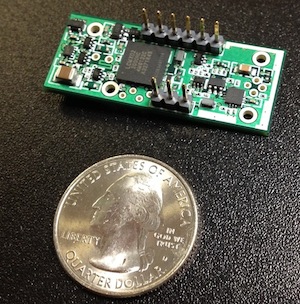LIDAR-Lite: A New Benchmark for Optical Distance Measurement Sensors
The founders of PulsedLight, Bob Lewis and Dennis Corey, recognized that there was an unmet need for an optical distance measurement sensor technology that addressed applications where a very small, low-power, high performance, reduced cost optical ranging sensor was required, such as robotics and UAVs. So in 2011 they co-founded PulsedLight, LLC in Bend, Oregon to bring their vision for a new optical ranging sensor technology to market.
After more than two years of work, we are ready to introduce our technology in the form of the LIDAR-Lite, a very small form factor, optical distance measurement sensor capable of measuring out to 40 meters using inexpensive, off-the-shelf, electro-optical components.
First, a Little Science
All optical ranging sensors use the principle of “Time-of-Flight” (ToF) to calculate distance to a target. Simply put, ToF calculates the time it takes for a signal, light in this case, to travel from the sensor to a target and back to determine distance.
Pretty simple in concept…
But, as the target gets farther away or you want to measure distance in bright light or against non-reflective targets, the transmitted beam has to be more powerful and/or collimated. In other words, you need a laser and a power source to support the laser.
Because light travels really, really fast, 299,792,458 meters per second or 1mm in 3 picoseconds, you need a very precise clock to measure the signal’s round trip. And in order to reliably detect the return signal, the detector needs to be very sensitive.
All of this, very collimated light sources (lasers), very sensitive detectors and super precise clocks are the reason even the least expensive optical range finders can cost hundreds of dollars.
PulsedLight’s Solution
We have created a series of new innovations which applies edge based signal reconstruction methods, similar to that used in radar, to optical rangefinders and also incorporates signal correlation processing to perform a "signature match" between a captured transmit signal record and the received signal. This specialized signal processing method enables a single-chip processing implementation using programmable logic chips suitable for low cost, ultra-small optical distance measurement sensor applications.
This approach allows us to:
- Recognize and process a very weak return signal.
- Quickly and accurately calculate distance without having to directly measure it real-time. In other words, we don’t need a super precise clock to make it all work. (Our acquisition time is 0.05 second and measurement accuracy for the LIDAR-Lite is 5%.)
- Implement our core technology in a single, system-on-chip solution, enabling sensors that have the lowest complexity hardware, and size.
- Create a sensor that is easily reconfigurable via software control.
In simple language, our technology extracts the maximum performance out of the emitters and detectors used. In the LIDAR-Lite we use components similar to those found in a TV remote control system to create a sensor that can measure distances out to 40 meters in a module that measures 51mm long X 30mm wide X 39mm tall.
Our processor-based approach also means that the modules can be easily configured under software control to operate in different modes; proximity detection, distance or velocity measurement. Modes can even be changed “on-the-fly”. Pun Intended….
The experience gained from developing long-range sensors for industrial and consumer products has been applied to this design allowing us to maximize its performance. The resulting tests of early prototypes, including flying it on a UAV, have been very promising.
The beam width of the LIDAR-Lite as delivered is 1.5°. This narrow beam provides long-range performance and also enables better target selectivity than an ultrasonic sensor. The optics can be removed increasing the beam width to about 6° and reducing range to approximately 5 meters. This broad, short-range beam is great for applications, such as proximity detection.
Operating from a 5vdc power source and drawing only 100 milliamps peak power when it is taking a measurement and under 10 milliamps when idle, the LIDAR-Lite is ideally suited for projects running from battery sources where low power consumption is critical.
The I2C communications interface allows multiple modules to be connected as slaves to a common communications bus.

The combination of attributes found in the LIDAR-Lite- high performance, low cost, small size, light-weight, low power consumption, and dynamic configurability along with I2C communications and addressing - means that it becomes practical to install multiple sensors on a project with minimal weight and power penalties. For more details, check out the LIDAR-Lite specification and data sheet.
If we are able to get this kind of performance from an LED, why aren’t we offering a laser-based LIDAR-Lite 100? Eye safety… Installing a laser would be the next logical step. However, before you can sell a laser-based device, even a simple laser pointer, it’s necessary to obtain eye safety certification. This takes additional time and delays the delivery of our technology to you. But, by supporting our campaign on Dragon Innovation today, you move us closer to being able to offer this capability in the near future.
We have a developed a revolutionary optical sensing technology that can be used in a variety of applications. We are excited to see what you will do with it and your support enables us to realize our goal of making our technology widely available to a large community of creative people. Thank you in advance for your support.


